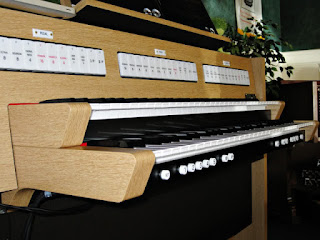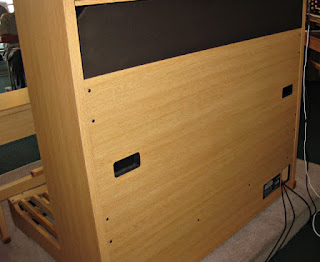
I had the opportunity early this month to attend a luncheon and demonstration of the new Roland C-330 Classic Organ by Hector Olivera at Heritage Church Organ Company.

I was initially intrigued by the size. With an older organ plus two external speakers taking up a large amount of space in my living room, the compact footprint of this new organ with satellite speakers that tuck away into the back of the organ would be a welcome change.

At first glance, the stops did not look impressive to me. With 33 stops, it seemed to cover just the very basics of organ registration.



Then the demonstration began, and I was amazed.
This tiny organ is magnificent. Beginning with Bach's organ in Arnstadt, Maestro Olivera took us on a wonderful journey through time, exposing us to organs throughout the world and through the centuries. Every one of these organs was played on this tiny new Roland, and I felt as if I were being transported to each church and cathedral as he played.
Then we were introduced to the orchestral oboe, clarinet, flute, and trumpet. I never imagined such sound could come from an organ! The pedal harpsichord was just icing on the cake.
The stoplist is extremely large, with three alternate voice palettes totaling 108 voices, plus an additional 72 which can be accessed on any keyboard through two user selected stops on each. Unlike with some other organs, palettes can be mixed and matched at will.
The keyboards have "true" tracker action (they even make wind noise when no stops are pulled), and are velocity sensitive for stops such as the orchestral trumpet.
My favorite feature, however is that no computer is needed to change the stops of the organ. Volume, octave, chiff, presence, warmth, windchest panning, and more are at your fingertips.

I can't even begin to cover everything that this organ does in one post. For more information, you can fill out a form on this website, or read the information on the official Roland site.
Oh, and if you want to buy one for me, I won't complain. :)
August 7, 2010 Update: I had the opportunity to play on this organ this past week at the BYU Organ Workshop. The built in speakers aren't nearly as powerful as the speakers in the above videos. They sound cheap. It also lacks a sub-woofer (which you can purchase separately), so the bass isn't as prominent, either. Also, in the bit of time I had to play with it, I did not see how to change all of the fun things (like chiff, presence, etc.). I was unable to mimic Hector's sounds. It is still a good little organ, and the price is "affordable," relatively speaking. It just wasn't as impressive when I played it as it was when Hector Olivera played it, which is to be expected, but was disappointing, nonetheless.




This review prompted me to create a series of books for this and other Rodgers organs that gets you playing all the sounds in the organ right away, from day one, hoping to eliminate the frustration that Jennifer experienced. Jennifer, thank you for writing a very honest review and inspiring me to create ways for people to access all the sounds in these organs right away!
ReplyDeletenoel jones, aago
What a good idea!
Deletehow much is this instrument?
ReplyDeleteI honestly cannot remember. Definitely under $20,000. I think it was under $14,000. I wish I could remember.
DeleteI've had one of these for nearly two years, The Speakers are really good, to get the best setup I had to go into the advance menu. To set the frequency of the bass speakers. I can play all sorts of repertoire on this instrument from the quiet strings of Howells to Large pieces such as Franck and Vierne. Im Currently learning the Liszt Prelude & Fugue on BACH.
ReplyDeleteHow did you access the advanced menu?
DeleteThanks for a great review!
ReplyDeleteThe C330 is a superb organ for the size. The great competitor these days however is Hauptwerk: a software organ where you purchase additional organs painstakingly recorded. These extra organs are usually a few hundred dollars each. Your main expense is the hardware - in particular getting a pedalboard. Your review of the C330 was great though: thanks for providing such a short and clear explanation!